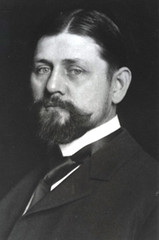George F. Kunz correspondence, 1894 - 1931
Creator
- Name
- Kunz, George F. (George Frederick), 1856-1932
- Abstract
- Mineralogist and gem expert George F. Kunz (1856-1932) became a vice president at Tiffany & Company at the age of 23, a position he held until his death.
Administrative Information
Access
Collection open to all researchers.
Preferred Citation
George F. Kunz correspondence, 1893-1931, Archives, American Numismatic Society.
Restrictions
Copyright restrictions may apply. Permission to publish or reproduce must be secured from the American Numismatic Society.
Biographical Note
Mineralogist and gem expert George F. Kunz (1856-1932) became a vice president at Tiffany & Company at the age of 23, a position he held until his death. He was born in New York City, was raised in Hoboken, New Jersey, and attended public schools and Cooper Union. He was in charge of the mining exhibits at the Paris Exposition (1889), the Kimberley, South Africa, Exposition (1892), and the Chicago Columbian Exposition (1893) and was a special agent at the Paris Exposition (1900) and commissioner on radium at the St. Louis Exposition (1904). A gem collector and discoverer, he traveled the world in search of pearls and gemstones, which he sometimes named after his associates and patrons, calling one rare find tiffanyite, after Charles L. Tiffany, and another morganite, after J. Pierpont Morgan. Kunzite, a mineral, is named after him. He wrote The Gems and Precious Stones of North America (1890) and The Curious Lore of Precious Stones (1913). Kunz became a resident member of the American Numismatic and Archeological Society (later the American Numismatic Society) in 1893 and was made a life member in 1913. He served as a link between the Society and Tiffany & Company and played a role in the company’s production of Columbus medals for the Chicago exposition of 1893. In 1897 he was made secretary of a committee established to produce a Ulysses S. Grant medal. He also served on the Society’s committees on papers and publications, American insignia, and U.S. medals, and was corresponding secretary in 1898 and 1899. Kunz was active in the society’s efforts to impove U.S. coinage, proposing, for example, the adoption of the metric system.
Scope and Content Note
Letters received by Kunz, with only a few copies of outgoing letters from him, on topics relating to numismatics. These include letters from Charles T. Cook at Tiffany & Company (he would become president of the company in 1902) discussing his recommendation of the adoption of a Christopher Columbus medal and the costs and other issues associated with the production of other medals (1893); letters from Bertha Palmer (1893), Sigmund Oettinger (1893), and National Sculpture Society founder Frederick Wellington Ruckstuhl (later Ruckstull) (1894 and 1895); a letter from Augustus Saint-Gaudens discussing his controversial Columbus medal reverse design that had been rejected by the United States Mint (1894); items pertaining to the American Numismatic and Archaeological Society (later the American Numismatic Society), including the nomination of Samuel P. Avery and other routine issues and a certificate acknowledging a gift to the Society of items from the Pan-American Exposition at Buffalo, 1901 (1894-1906); a letter from Victor David Brenner expressing his desire to cut the dies for a Ulysses S. Grant medal, which were instead later cut by Tiffany & Company (likely 1897); a letter and business card from engraver Rudolph Laubenheimer expressing interest in the proposed Grant medal (ca. 1897); a letter regarding his two exhibits at the Paris Exposition of 1900 (1899); a letter regarding a proposed Rumphius Medal in the Netherlands (1902); letters from the U.S. Mint, including one from curator Thomas Louis Comparette regarding President Roosevelt and the new designs for the double eagle (1907) and another from mint director George Roberts in which he is critical of what he considered to be Chief Engraver Charles Barber’s disagreeable attitude, which in this case arose from difficulties with hubs that had not been produced by the U.S. mint, along with Barber’s drawings and technical report (1914); three Adolph Alexander Weinman letters relating to Roosevelt’s Inaugural Medal (1909); several letters from coin collector James W. Ellsworth, one of which raised questions about mint employees selling rarities, in this case a Saint-Gaudens double eagle (1915-1918); a letter from Thomas Hastings of the architectural firm Carrère and Hastings thanking Kunz for an Avery medal (1915); and a small group of letters having to do with the new U.S. coin designs of 1916, including a letter from Weinman, designer of the Walking Liberty half dollar and the Mercury dime, and a letter from Hermon Atkins MacNeil, designer of the Standing Liberty quarter. Also present is a photograph of MacNeil sent to Kunz by him, and an annotated typescript, “The Designers of the New Silver Coinage,” which provides biographical information on Weinman and MacNeil. Another untitled typescript discusses the relative permanence of materials used to record human history, such as paper, papyrus, and metal coins. In addition there is a folder labeled “St. Gaudens Columbian Medal,” containing one photocopy (1908) and two original (and possibly unrelated) letters (1909 and 1921), a news clipping (1907) and photocopies of American Journal of Numismatics articles (1891, 1894, 1896).
Related Entities
Organization
Person
- Kunz, George F. (George Frederick), 1856-1932
- Cook, Charles T.
- Weinman, Adolph A. (Adolph Alexander), 1870-1952
- MacNeil, Hermon Atkins, 1866-1947
- Hastings, Thomas, 1860-1929
- Ellsworth, James W. (James William), 1849-1925
- Barber, Charles Edward, 1840-1917
- Roberts, George
- Brenner, Victor D. (Victor David), 1871-1924
- Avery, Samuel Putnam, 1822-1904
- Saint-Gaudens, Augustus, 1848-1907
- Laubenheimer, Rudolph
- Oettinger, Sigmund
- Palmer, Bertha Honoré, 1849-1918
- Comparette, T. Louis (Thomas Louis), 1868-
- Ruckstull, F. W. (Fred Wellington), 1853-1942
